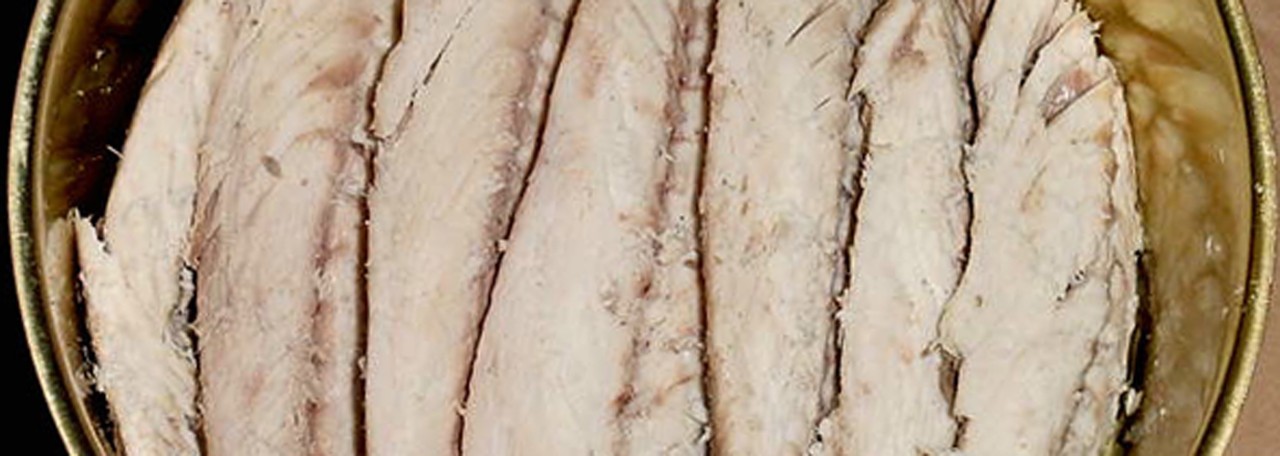.png.transform/rendition-xs/image_image%20(1).png)
Melva de Andalucía PGI
Melva (frigate mackerel) fillets in olive or sunflower seed oil, prepared by hand. The raw materials used for frigate mackerel preserve from the species Auxis rochei and Auxis thazard.
Tasting notes
For frigate mackerel preserve: pinkish color meat, firm texture, smooth and juicy, pleasant smell and distinctive flavor, different from other member of the tuna family. Bullet tuna preserved in oil, the raw material for which also comes from the two species already mentioned when its weight is below 600 gr / 21.16 oz, is grayish white in color and acquires excellent and highly sought after qualities for its meat, its firm texture, pleasant smell and distinctive flavor. Skinned by hand to guarantee a natural flavor.
Other notes
The main feature of how these preserves are made is that the fish are skinned by hand, without the use of any kind of chemical product or preservatives at any stage or in the final product. Equally, only olive or sunflower oils are used as covering liquids.
Production / Processing method
The head is removed and the product is gutted and washed until blood and mucous have been removed. The cooking process involves placing the fish in boiling drinking water in which salt has been dissolved; during this process both pH and Cl values are carefully controlled. Next, the fish is skinned by hand, a particularly important process, as it uses no chemical products whatsoever, allowing the fish to keep all its natural qualities. Once the skin and bones have been removed from the fish fillets, the product is packaged in metal or glass containers, which are heat-sterilized in order to destroy any micro-organisms.
Geography / Relief and climate
The production area covers towns on Andalusia's Atlantic and Mediterranean coasts, on both sides of the Gibraltar Strait, with rich tuna fishing grounds yielding excellent quality fish. The climate in this area is quite varied, according to whether the coast faces the Atlantic Ocean or the Mediterranean Sea. The former enjoys an oceanic Mediterranean climate whose distinctive feature is the softening influence of the ocean, reducing annual the temperature range and making winters milder.
The average annual temperature is always over 10º C / 50º F, summer temperatures average around 25º C / 77º F, with maximum temperatures rising to over 40º C/ 104º F only in exceptional circumstances. Annual rainfall is not too abundant, at around 500 and 600 mm, with most of the rain falling in the winter, followed by dry summers.
The area has plenty of sunshine, with 3,000 hours of sunlight per year in some places. The Mediterranean coast of Andalusia has a typically sub-tropical Mediterranean climate. The most characteristic feature of this environment is its mild winters, caused by three basic mechanisms: the warming effect of the sea, the south-facing coast, which soaks up an exceptional amount of sunlight, and its position, protected from the winds coming down through the northern ravines by the Bética mountain ranges.
Average monthly temperatures in winter are between 12º C / 53.6º F and 15º C / 59º F, with minimum temperatures being particularly high, making the risk of frost practically negligible. Summers are not too extreme, owing to the cooling sea breezes, but there are sometimes periods of intense heat as a result of hot winds from inland, pushing the temperature up to 40º C / 104º F.
Rainfall varies widely from place to place, but generally becoming lower from west to east, from the very rainy weather frequently experienced in the Gibraltar Strait to the sub-desert areas on the coast of Almería.
The Atlantic coast is almost completely flat and sandy, with no cliffs and hardly any rocks, as there are no mountains nearby. It has huge beaches, like the ones in Huelva and Cádiz. These beaches sometimes have enormous sand dunes.
The Mediterranean coast is much more rocky and abrupt, as the Penibética mountain range is very close to the sea. It has cliffs, vast beaches and tiny coves.
The fish products preserves industry in Andalusia is part of a time-honored tradition that is still active today. The Andalusian preserves industry continues to uphold the features that give it outstanding quality and that can be defined as follows: the local fish species found in Andalusian coastal waters, the family companies that have been making preserves for generations, and the traditional artisan methods they employ.
Regulatory Council
Consejo Regulador de la IGP Caballa y Melva de Andalucía
C/ Glorieta del Agua, 4
Edificio Ajamar Center – 2ª planta, oficina nº 9
41940 Tomares (Sevilla)
Andalucía
Tel: (+34) 954 151 823
consejoregulador@caballaymelva.com
www.caballaymelvadeandalucia.com
Sources:
The fish is skinned by hand, a particularly important process, as it uses no chemical products whatsoever.


- /content/dam/en/icex-foodswines/images/products/preserves/melva-de-andalucía-pgi/Melva%20de%20Andalucía%20PGI%20carr1.jpg
- /content/dam/en/icex-foodswines/images/products/preserves/melva-de-andalucía-pgi/Melva%20de%20Andalucía%20PGI%20carr2.jpg

Tomares (Andalusia)
